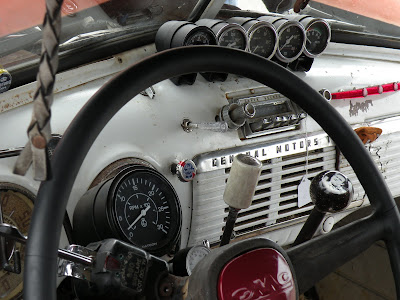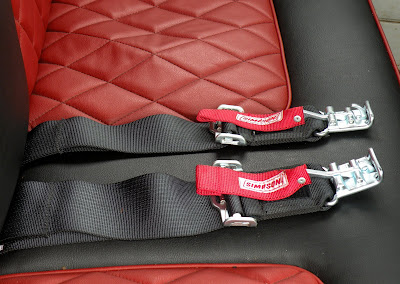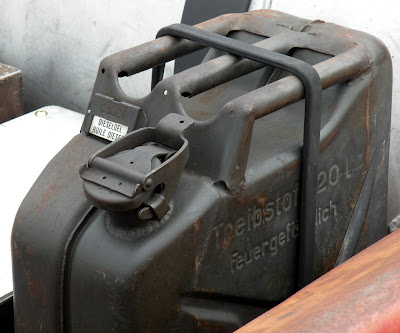










 A real gerry can; German fuel can, world war 2 era. Easliy trasportable fuel for tanks and transport trucks was vitally important, and the invention of this fuel can that was rugged and didn't leak was the solution. They may have been a substantial reason for the allies winning the European and African theaters in WW2
A real gerry can; German fuel can, world war 2 era. Easliy trasportable fuel for tanks and transport trucks was vitally important, and the invention of this fuel can that was rugged and didn't leak was the solution. They may have been a substantial reason for the allies winning the European and African theaters in WW2The history of the Jerrycan is notable because it was reverse engineered during World War II.
The name of the jerrycan reveals its German origins (Jerry being a disparaging wartime name for Germany and Germans).
The jerrycan was invented by the Germans during a secret project ordered by Hitler. The Germans called it the Wehrmachtskanister. The Germans had thousands of jerrycans stockpiled by 1939 in anticipation of war
In 1939, an American engineer named Paul Pleiss had built a vehicle to journey to India with his German colleague. After building the car, they realized they didn't have any storage for emergency water.
The German engineer had access to the stockpile of Jerrycans at Tempelhof Airport and just managed to take three. They drove across 11 national borders without incident until Field Marshal Goering sent a plane to take the engineer home. The German engineer compounded his treason by giving Pleiss complete specifications for the manufacture of the can. Pleiss continued on to Calcutta, put his car in storage, and flew back to Philadelphia.
Pleiss told American military officials about the can, but they ignored him. Without a sample, he realized he couldn't get anywhere. He eventually got the car shipped to New York by a roundabout method, and sent a can to Washington. The War Department decided instead to use the WWI ten-gallon can with two screw closures, which required both a wrench and funnel for pouring.
The one American jerrycan was sent to Camp Holabird, Maryland, where it was redesigned. It only retained the handles, size and shape. The weld was replaced with rolled seams, the lining was removed and it now required a wrench and a funnel.
The original design proved far superior and these fuel containers were subsequently used in all theatres of war around the world.
At the beginning of the Second World War, the British Army were equipped with simple rectangular fuel containers: a 2 gallon container made of pressed steel and a 4 gallon container made from tin plate. While the 2 gallon containers were relatively strong, they were expensive to produce. The 4 gallon containers, which were mainly manufactured in the third world, were cheap and plentiful but they were not very robust. Consequently they were colloquially known as flimsies.
While adequate for transportation by road in Europe, the flimsies proved to be extremely unsatisfactory during the North African Campaign and severely hampered the operation of the British 8th Army. The transportation of fuel over rough terrain often resulted in much of the fuel being lost as the containers were easily punctured. The resultant leakages also made the transportation vehicles liable to fuel fires.
When the British Army first saw the German fuel cans during the invasion of Norway in 1940, the British immediately saw the advantages of the superior design. The containers had three handles on them, which allowed easy handling by one or two people, or to be moved bucket brigade-style; the sides of the can were marked with cross-like indentations that strengthened the can while allowing the contents to expand, as did an air pocket under the handles when the can was filled correctly.
Rather than a screw cap, the containers used a cam lever release mechanism with a short spout secured with a snap closure and an air-pipe to the air pocket which enabled smooth pouring (which was omitted in some copies). The interior was also lined with an impervious plastic, first developed for steel beer barrels that would allow the can to be used for either water or gasoline. The can was welded, and had a gasket for a leak-proof mouth. The British used cans captured from the "Jerries" (Germans) � hence "jerrycans" � in preference to their own containers as much as possible. Later in 1940 Pleiss was in London, and British officers asked him about the design and manufacture of the jerrycan. Pleiss ordered the second of his three jerrycans flown to London. via: http://en.wikipedia.org/wiki/Jerrycan



0 comments:
Post a Comment